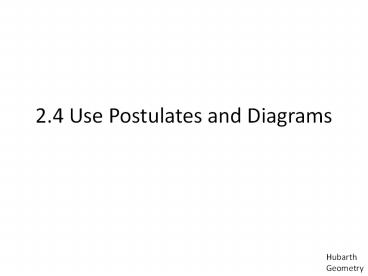2.4 Use Postulates and Diagrams PowerPoint PPT Presentation
Title: 2.4 Use Postulates and Diagrams
1
2.4 Use Postulates and Diagrams
Hubarth Geometry
2
Postulates Point, Line and Plane
Postulates Postulate 5 Through any two points
there exists exactly one line. Postulate 6 A line
contains at least two points. Postulate 7 If two
lines intersects, then their intersection is
exactly one point. Postulate 8 Through any three
noncollinear points there exists exactly one
plane. Postulate 9 A plane contains at least
three noncollinear points. Postulate 10 If two
points lie in a plane, then the line containing
them lies in the plane. Postulate 11 If two
planes intersect, then their intersection is a
line.
3
Ex 1 Identify a Postulate Illustrated By a Diagram
State the postulate illustrated by the diagram.
a. Postulate 7 If two lines intersect, then
their intersection is exactly one point.
b. Postulate 11 If two planes intersect, then
their intersection is a line.
4
Ex 2 Identify Postulates from a Diagram
Use the diagram to write examples of Postulates 9
and 10.
Postulate 9 Plane P contains at least three
noncollinear points, A, B, and C.
Postulate 10 Point A and point B lie in plane
P, so line n containing A and B also lies in
plane P.
5
Interpreting Diagrams When you interpret a
diagram, you can assume information about size or
measure only if it is marked. You Can
Assume You Cannot assume All points shown
are coplanar G, F, and E are collinear
P
.
.
C
B
.
H
A
J
.
.
.
.
D
F
E
G
6
Ex 3 Use Given Information To Sketch a Diagram
7
Ex 4 Interpret Diagram in Three Dimensions
A, B, and F are collinear.
E, B, and D are collinear.
8
Practice
1. Which postulate allows you to say that the
intersection of plane P and plane Q is a line?
Postulate 11
2. Use the diagram, to write examples of
Postulates 5, 6, and 7.
3. If the given information stated PW and QW are
congruent, how would you indicate that in the
diagram?
4. Name a pair of supplementary angles in the
above diagram. Explain.
PowerShow.com is a leading presentation sharing website. It has millions of presentations already uploaded and available with 1,000s more being uploaded by its users every day. Whatever your area of interest, here you’ll be able to find and view presentations you’ll love and possibly download. And, best of all, it is completely free and easy to use.
You might even have a presentation you’d like to share with others. If so, just upload it to PowerShow.com. We’ll convert it to an HTML5 slideshow that includes all the media types you’ve already added: audio, video, music, pictures, animations and transition effects. Then you can share it with your target audience as well as PowerShow.com’s millions of monthly visitors. And, again, it’s all free.
About the Developers
PowerShow.com is brought to you by CrystalGraphics, the award-winning developer and market-leading publisher of rich-media enhancement products for presentations. Our product offerings include millions of PowerPoint templates, diagrams, animated 3D characters and more.

